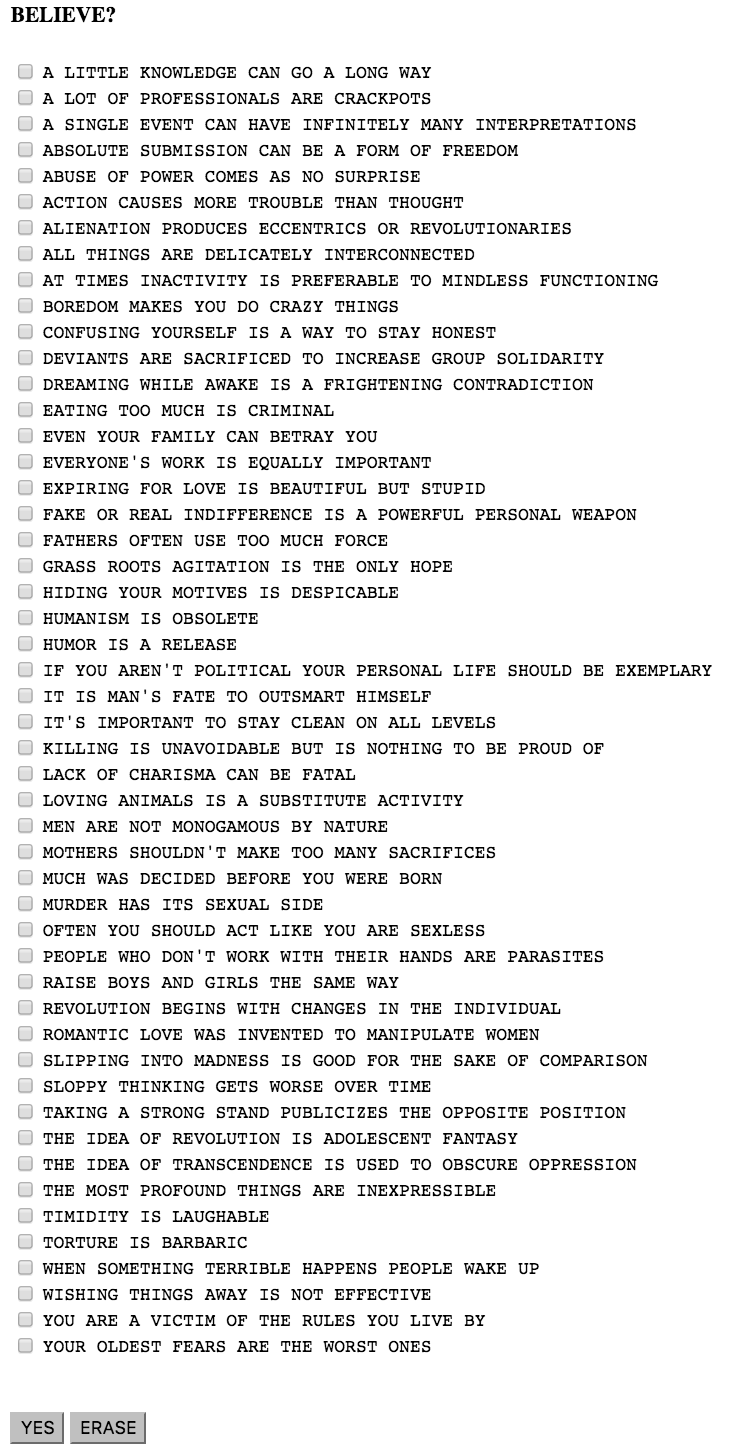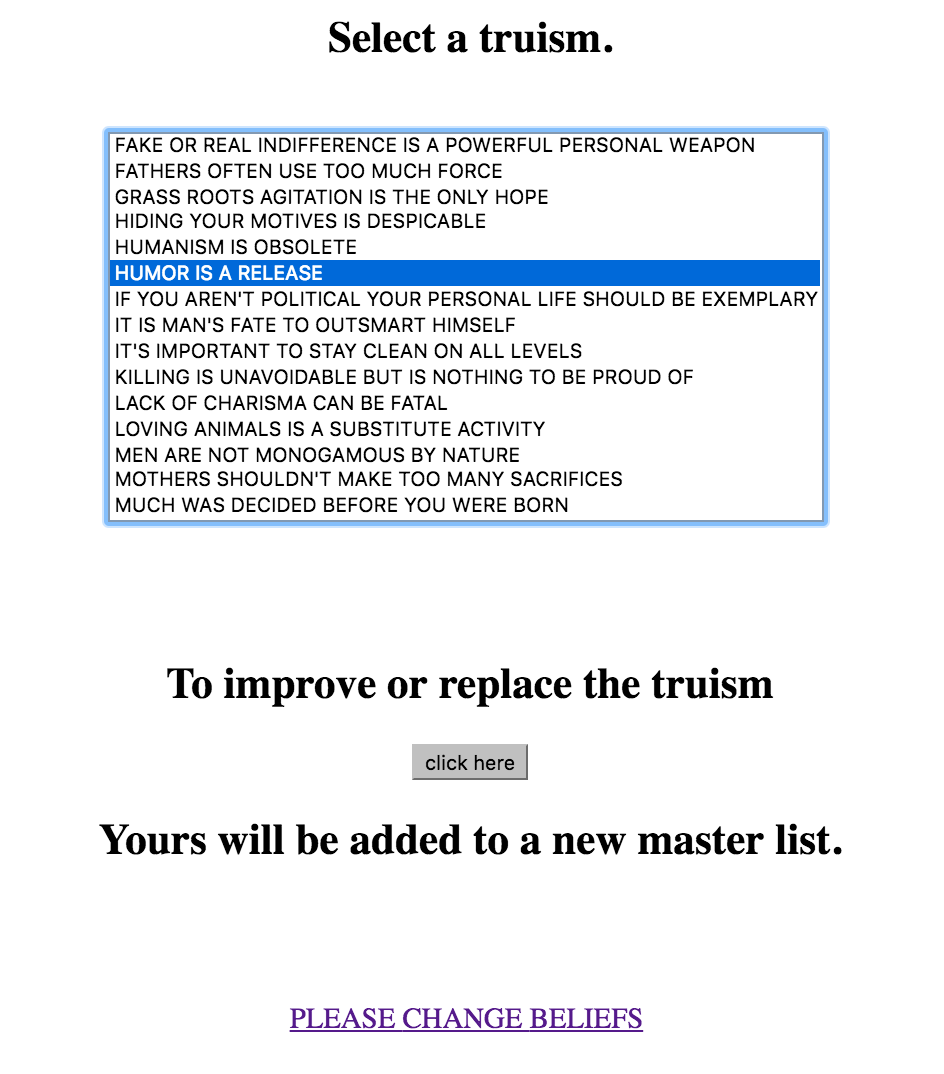Jenny Holzer’s work largely revolves around text in public spaces. Her iconic Truisms (1978-87) have been displayed in public spaces through a variety of means such as photocopied posters, storefronts, billboards, electronic signs and even T-shirts.


Please Change Beliefs (1997) is a development of Holzer’s earlier work in physical public spaces. She sets up her truisms in a publicly accessible virtual space where visibility is not limited by geographical locations or proximity, demonstrating the “collapse of the local and remote into a networked space or ‘third space’.”[i]
Holzer further expands on this idea of accessibility, which is intrinsic to open source, by allowing anyone to alter and add to the work. The title itself is an invitation to reconsider and rewrite these notions of truth. The altered truisms are a mix bag of insightful, ludicrous, dark, humorous, skeptical and optimistic. We inevitably identify with some of these appended truisms, destabilizing the seemingly fixed and timeless definition of ‘truth’.

Although it is facilitated by Holzer, the work moves away from the conventional ‘artist-audience’ model to the “collaborative, many-to-many systems of writing [and] media-making”.[i] By partaking in this editing of truisms, the users are converted from audience to participant to contributor. Furthermore, the work functions as an expanding database of collective thoughts and ideas. It exemplifies the notion of a collective narrative created with a potentially infinite number of minds, coming together in a single ‘third space’.

Text as Medium
As highlighted by Galloway and Rabinowitz, the “virtual space creates social situations without traditional rules of etiquette [and] diminishes our fears of interaction”.[ii] Contributors can proclaim these truisms, without attaching authorship or receiving backlash. Furthermore, the use of text instead of image makes it less intimidating as anyone connected to the web has an equal say.
This, coupled with the sense of anonymity, are important factors in maintaining the rawness and authenticity of these altered personal ‘truisms’. Overall, I believe that Holzer’s work is effective in writing a global collective narrative, and does illustrate the following concept:
“This dramatically alters the act of writing and narrative, from the singular activity of a very personal form of individual expression, to a collective activity that is highly collaborative: all publishable instantaneously to a global audience.”
— Randall Packer, from “Collective Narrative” in the essay Open Source Studio (2015)
References
[i] Randall Packer (2015). “Collective Narrative” from the essay Open Source Studio.
[ii] Galloway, K. & Rabinowitz, S. “Welcome to Electronic Café International,” (1992) in Packer, R., & Jordan, K. (Eds.). Multimedia : from Wagner to Virtual Reality ([Expanded ed.). New York: Norton, 2002.

I find it interesting that you find the use of text instead of image, less intimidating, as anyone connected to the web has an equal say. Do you find the use of text on OSS and Adobe Connect, less intimidating than the use of images as well? I ask this because, this class rarely uses the chat function in Adobe Connect. However, I see you are all responding and commenting to one another mostly through text on OSS. Thanks.
I think while text may deliver more information, it has an element of anonymity especially in Please Change Beliefs. Once I upload my contribution, its source is indistinguishable from the rest. IMO, images on the other hand are far more revealing of me as an author, and thus more intimidating.
A part of me remains suspicious of whether text is sufficient as a medium to express the rawness of one’s feelings. From a postmodern standpoint, the inherent meaning of text itself might override what you think you are feeling, rather than feeling it.
Valid point Tania! Perhaps I should clarify… I agree that in expressing feelings, there are many other mediums such as image or music that may be more suitable! But in expressing a belief or thought, text can be very effective due to its immediacy. When we edit a truism in text (compared to uploading an image or video), most people wouldn’t over-analyse or doubt the worth of their contribution, which lends a raw quality to these personal beliefs 🙂
Great discussion! I was intrigued by your reference to anonymity, that viewer-contributors were protected in a sense by remaining anonymous. I think you are suggesting that this lends a certain openness to people expressing themselves. I am curious how you think this openness differs from social media, in which users generally reveal, or must reveal, their identity.
I like the point you brought up of how the anonymity is also a factor to bring up and maintain the rawness and authenticity of the altered ‘truisms’, where it could also be applied to other instances on the net these days.